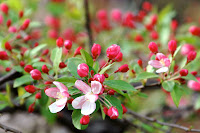When I left my two-acre Connecticut garden for a postage stamp in Georgetown, friends and acquaintances alike asked me in sympathetic tones “how can you leave your garden?” I smugly rejoined that I was moving to a place where I would “have” several gardens, like the one designed by Beatrix Ferrand at Dumbarton Oaks, where I can meander at will without having to fuss about ground hogs, weeds, pruning, etc. I imagine it’s a bit like being a grandparent: You get to enjoy your grandchildren and then hand them back to their parents when they need changing or hit puberty.
With this in mind, to escape the Capitol’s preoccupation with a threatened government shutdown and enticed by an e-mail announcing that the “gift shop is in Bloom” I headed to Dumbarton for a stroll. Arriving in late afternoon, I bought a reasonably priced season pass and found that it is not only the shop that is in bloom. The gardens are at that glorious mid-spring moment when nearly naked trees and shrubs stand side by side with others heavily endowed with breathtaking blossoms and spring green leaves – quite literally breathtaking, as my allergies suggested.
 |
| Dumbarton's ancient katsura |
I love Dumbarton not just for its rich panoply of plants, but also for it’s stunning layout. It has good bones so it is just as beautiful in mid-winter, bereft of leaves and flowers, as it is in peak spring, a test of good garden design. While it is full of Italian, French, and British influences, and its plants hail from the four corners, I like to think of it as truly American, a melting pot of influences yielding a unique and inspiring result still evident though Farrand’s original design has been altered over time.
While you can walk straight up to the gardens along the gravel drive from the R Street entrance, I prefer to enter along the shaded, shrub enclosed walk on the south side of the East Lawn to pay homage to the ancient Katsura (cercidiphyllum japonicum) featured there. The leaves on this Asian native, which turn a gentle yellow-orange in fall, are heart shaped, which is what “cercidiphyllum” refers to, but they are not yet out. As a result, this specimen’s magnificent structure, from root to twig and stark against the fresh greenness of the spring lawn, is completely captivating. Whether upright or weeping, Katsuras are hardy in zones 4-8, require consistently moist soil, and are a superb choice for large spaces.
 |
| Yellow epimediums |
 |
| Dark pink epimediums |
Deep in the heart of the gardens, I stumbled into the Prunus Walk where the flowering plums (Prunus x blireana) were peaking. I know I should have been more excited about these trees, replacements for the original yew hedge, but I was utterly mesmerized by the groundcover beneath them. There, blooming above a dusting of fallen plum petals is deep pink and pale yellow Bishop’s Mitre (epimediums). There are over 60 species of epimediums, some of which are purported aphrodesiacs, hence another common name: “Horny Goat Weed”. They are low growing hardy perennials, mostly from China and central Asia. Charming enough for their heart shaped leaves and drought tolerance, their delicate blooms are to die for – tiny flowers resembling a miniature cross between daffodils and columbines and ranging in color from yellow to white to lavender and this delicious dark pink. My epimediums in Connecticut, unmolested by deer and groundhogs, were too far from the house to be enjoyed. Now I will include them along my front walk where they will revel in part shade and I can easily see them.
 |
| Pink crabapple just breaking bud |
Crabapple Hill is just starting to peak as well. It’s worth the hike up from the lower gardens to see these trees breaking bud. I love crabapples (Malus) because many varieties are nearly as beautiful in fall and winter as they are in spring when they bear beautiful small persistent red, orange, or yellow fruits. The trick when choosing crabapples is to be sure you have one of the fruiting varieties that are disease resistant because, as members of the rose family, they are susceptible to nasty blights that can leave them looking perfectly horrible in mid-summer.
 |
| Icy blue Ipheon -- the darker ones are gorgeous, too |
In front of the house I came across one of my favorite bulbs in full stunning bloom. Spring Starflower (Ipheon uniflorum), from southern South America, is a fantastic shade of icy blue (it also comes in white, dark violet and pink) and is perfectly sited in slightly shady spot beneath a blooming pink and white viburnum. Its slightly garlicky smell is off-putting to squirrels, which otherwise flagrantly dine on tulip and crocus bulbs, and it naturalizes beautifully. It needs to be tucked where its fall grass-like leaves are not annoying, just like the Armenian grape hyacinth (muscari armeniacum) that blooms near Dumbarton’s main gate. Indeed, I recommend planting them together because they are an eye-catching combination.
 |
| Swathes of muscari |
The guards at the gate are very polite, but I took the hint the third time they asked me if I’d enjoyed the gardens. It was closing time, so I thanked them for their patience, and reluctantly walked through the graceful gates. With my season pass snug in my wallet, and Dumbarton’s excellent gardeners on duty, though, I know I can come back any day between 2-6pm, except on Mondays, to enjoy “my garden” again.

No comments:
Post a Comment